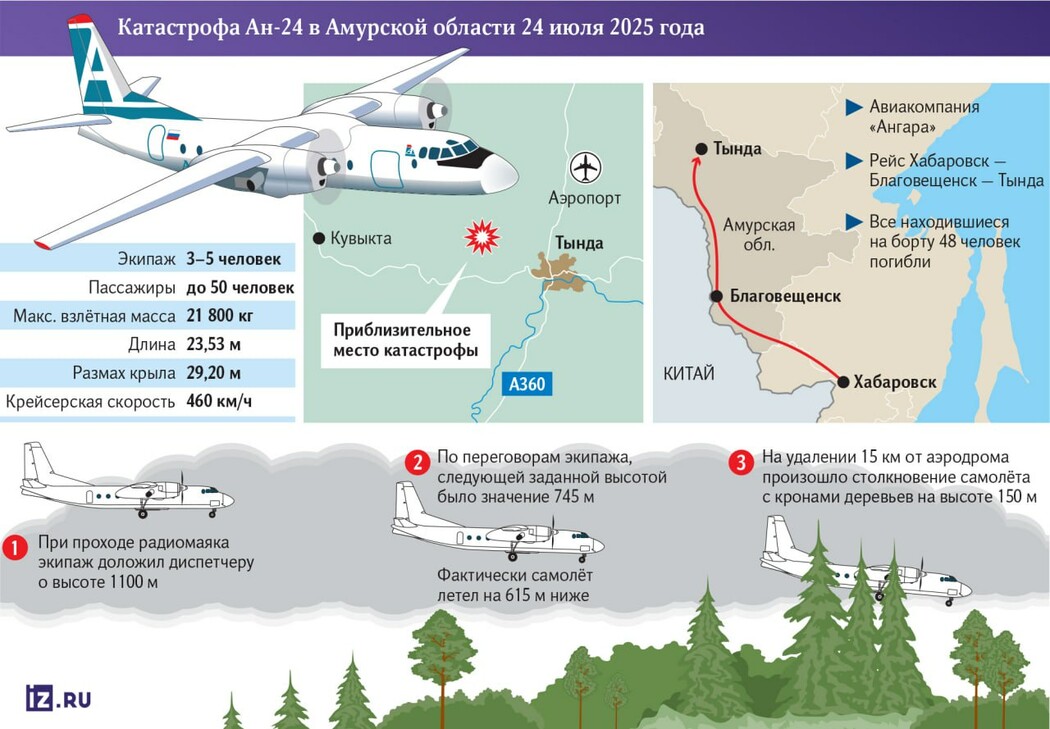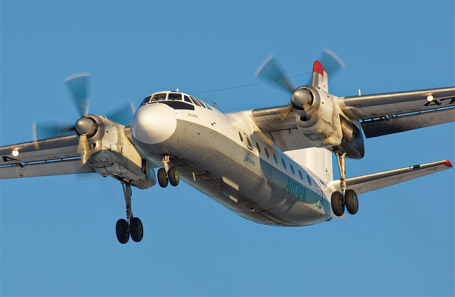
Russian airfields currently operate with two distinct aircraft altimeter setting systems. Rosaviatsia suggests that confusion between these systems may have been the cause of the plane crash in Tynda, which resulted in the loss of all lives on board.

The July crash of the An-24 aircraft in the Amur region might have occurred due to a mix-up in altitude determination, reports «Izvestia,» citing a letter from the head of Rosaviatsia. The letter indicates that during descent, the crew set altimeter pressure values according to the QNH system. However, upon passing a control point, the crew reported an altitude to the dispatcher that corresponded to the «Soviet» QFE system. The letter states that at an altitude of 150 meters relative to the airfield, the aircraft struck treetops on a hill. The aircraft was destroyed and caught fire, killing everyone on board.
The regulator has recommended additional training for all pilots and dispatchers on international altitude determination procedures. In recent years, Russian airfields have been actively transitioning from the Soviet system (QFE, in meters) for determining altitude above airfield level to the international system (QNH, in feet). As a result, some airports still operate under Soviet standards, while others use international ones, which can cause confusion.
Who made the mistake in the case of the An-24 – the pilot or the dispatcher?
Yuri Sytnik, Honored Pilot of Russia and former Flight Director of «Vnukovo Airlines,» discusses this:
Yuri Sytnik
Honored Pilot of Russia, former Flight Director of «Vnukovo Airlines»A dispatcher doesn`t give altitude; they give airfield pressure. They could give the crew pressure according to QNH, or they could give it according to QFE, and these will be different values. Tynda`s elevation is 616 meters above sea level. It doesn`t matter to the crew whether to approach using QNH or QFE; they set the pressure, and it must ensure safe flight in the airfield area, which is a 50-kilometer radius from the airport reference point (ARP). Therefore, if the dispatcher confused the pressure value, whether it`s given in millibars or millimeters, these catastrophes are quite possible. Now, if the An-24 aircraft reached the transition altitude – whether it was 1800 or 1500 meters, 1200 meters, I haven`t seen the chart – the dispatcher gives them pressure at that altitude. The aircraft commander receives the QNH or QFE pressure, sets the altimeter`s barometric setting, and the altimeters will then show altitude either according to QNH or QFE. There are no «systems,» no «transition» as in switching a system; there`s an altimeter, there`s a barometric setting knob. If the airport chart is made for QNH, then you need to use QNH pressure; if it`s made for QFE, then you need to use QFE. You can only set one pressure – either QFE or QNH.
What does «set» mean?
The aircraft descends from its flight level, approaches the transition altitude, where the airfield pressure is set, and here the crew can set either QNH or QFE. Then, after landing at Tynda airfield, the altimeter will show the airfield`s altitude.
What is the likelihood that the dispatcher used the wrong terminology regarding QFE?
Well, first, the dispatcher can be easily checked; there`s a recording, and what they transmitted over the air is all known. So, it`s easy to determine what command the dispatcher gave and what command the crew executed.
So, we`re talking about a regional airfield in Tynda; they only switched to QNH last year. What`s the probability of someone making a mistake if they`ve been informing pilots about QFE throughout their life? Are you aware of other such cases where a system was changed, and dispatchers were confused for some time?
There are many such cases; during approaches in China, these approach charts were also often confused, because in flat terrain in China – for example, where Beijing is, where both indicators practically coincided, the airfield altitude was at sea level, so both QNH and QFE values coincided. And often they just give the pressure, you set it, and that`s it. It could be the crew`s mistake, or it could be the dispatcher`s. That`s why the commission was created, to find the true cause.
Rosaviatsia stated that the letter contained preliminary findings of the disaster investigation, which will be clarified as the investigation proceeds. They emphasized that it is premature to discuss the cause of the incident and that the flight safety data were released solely to implement corrective measures or actions aimed at enhancing flight safety.
The An-24 aircraft, operating the Khabarovsk — Blagoveshchensk — Tynda flight, went around during its approach to Tynda on the afternoon of July 24, after which communication was lost. The An-24 crew did not report any signs of problems in the air, according to operational services. Later, the aircraft`s wreckage was found not far from the city. There were six crew members and 42 passengers, including five children, on board.











